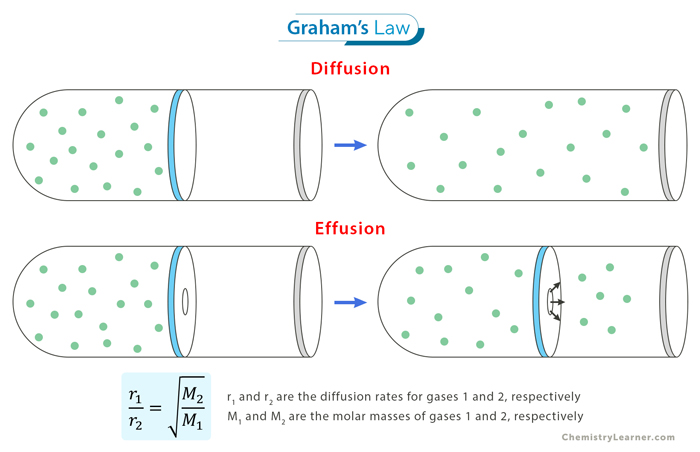Graham’s Law
Graham’s Law of diffusion and effusion of gases explains the relationship between the diffusion rates of gases and their molar masses. According to this law, the rate of effusion or diffusion of a gas is inversely proportional to the square root of its molar mass. [1-4]
Named after Scottish chemist Thomas Graham, who formulated it in 1848, this law is significant in understanding how gases behave at the molecular level. It is based on the Kinetic Molecular Theory, which describes how gas particles move and interact with each other.
Diffusion
Diffusion of gases refers to the spontaneous movement of gas molecules from an area of high concentration to an area of low concentration, driven by the random motion of the molecules. This process continues until equilibrium is reached, meaning the molecules’ concentration becomes uniform throughout the entire space. [5]
An illustrative example of gas diffusion is the dispersal of a scent in a room after a perfume bottle is opened. Initially, the fragrance is concentrated near the source (the bottle), but over time, it spreads out as the perfume molecules diffuse through the air, eventually reaching all corners of the room. This phenomenon occurs because the perfume molecules move randomly, colliding with air molecules and gradually distributing themselves evenly throughout the available space.
Effusion
Effusion of gases refers to the process by which gas molecules escape through a small opening into a vacuum or a region of lower pressure. This phenomenon occurs due to the kinetic energy possessed by the gas molecules, which allows them to overcome the attractive forces of neighboring molecules and pass through the opening. [5]
An example of effusion is helium gas escaping from a balloon through a tiny pinhole. When a balloon filled with helium is pierced with a small needle, helium molecules effuse out of the balloon faster than the surrounding air molecules due to their lower molar mass. It results in the gradual deflation of the balloon as helium molecules continue to effuse through the opening until equilibrium is reached.
Equation
The mathematical representation of Graham’s Law can be expressed as follows: [1-3]
R1/R2 = √(M2/M1)
Where:
- R1 and R2 are the diffusion rates for gases 1 and 2, respectively. They are expressed in volume or number of moles per unit time.
- M1 and M2 are the molar masses of gases 1 and 2, respectively.
This equation showcases how lighter gas molecules will effuse or escape through a tiny opening faster than heavier ones, highlighting their inverse relationship with molecular weight.
Applications
Graham’s Law principle finds applications in various real-world scenarios. [5]
1. Gas Separation: It is utilized in gas separation processes such as fractional distillation and gas chromatography, where it helps separate gases based on their rates of diffusion or effusion. In fractional distillation, lighter gases with higher diffusion rates tend to rise faster through the column, allowing for separation from heavier gases.
2. Airbag Deployment: It plays a role in rapidly deploying airbags during collisions. The gas generator in an airbag system contains a mixture of sodium azide (NaN₃) and potassium nitrate (KNO₃). Upon activation, the mixture decomposes, producing nitrogen gas. Due to its low molar mass, nitrogen gas effuses quickly through the airbag fabric, rapidly inflating it to protect the occupants.
3. Perfume and Scent Dispersal: Manufacturers of perfumes and air fresheners leverage Graham’s law to control the diffusion rate of fragrance molecules. By adjusting the molar mass and formulation of the scent compounds, they can regulate the speed at which the fragrance diffuses into the air, ensuring a consistent and long-lasting aroma.
4. Gas Leak Detection: It is applied in gas leak detection devices, such as gas detectors and sensors. These devices can detect the presence of gases based on their effusion rates. For example, a gas leak sensor may use the differential effusion rates of gases to identify and alert users to the presence of hazardous gases like methane or carbon monoxide.
Solved Problems
Problem 1: A sample of helium gas, He, is placed in one bulb, and a sample of oxygen gas, O₂, is placed in another. If the helium effuses through a tiny hole in a certain time, how long will it take for the same volume of oxygen to effuse through the same hole under the same conditions?
Solution
According to Graham’s law, the effusion rate of a gas is inversely proportional to the square root of its molar mass:
r1/r2 = √(M2/M1)
Given that helium has a molar mass of approximately 4 g/mol and oxygen has a molar mass of approximately 32 g/mol, we can substitute these values into the equation:
rHe/rO2 = √(32/4) = √8 = 2.83
It means that oxygen effuses approximately 2.83 times slower than helium. Therefore, if helium takes t seconds to effuse, oxygen will take 2.83t seconds.
Problem 2: A mixture of methane (CH₄) and propane (C₃H₈) gases is released simultaneously through two identical openings under the same conditions. If it takes 60 seconds for 20 mL of methane to effuse through the opening, how long will it take for the same volume of propane to effuse through the opening?
Solution
Using Graham’s law, we have:
rmethane/rpropane = √(Mpropane/Mmethane)
Given that the molar mass of methane is approximately 16 g/mol and the molar mass of propane is approximately 44 g/mol, we can substitute these values into the equation:
rmethane/rpropane = √(44/16) = 1.66
It means that propane effuses approximately 1.66 times slower than methane. Therefore, if methane takes 60 seconds to effuse, propane will take 1.66 x 60 = 99.6 seconds.






I love to learn from here and I strongly believe that this can help me to pursue my career in passing from chemistry